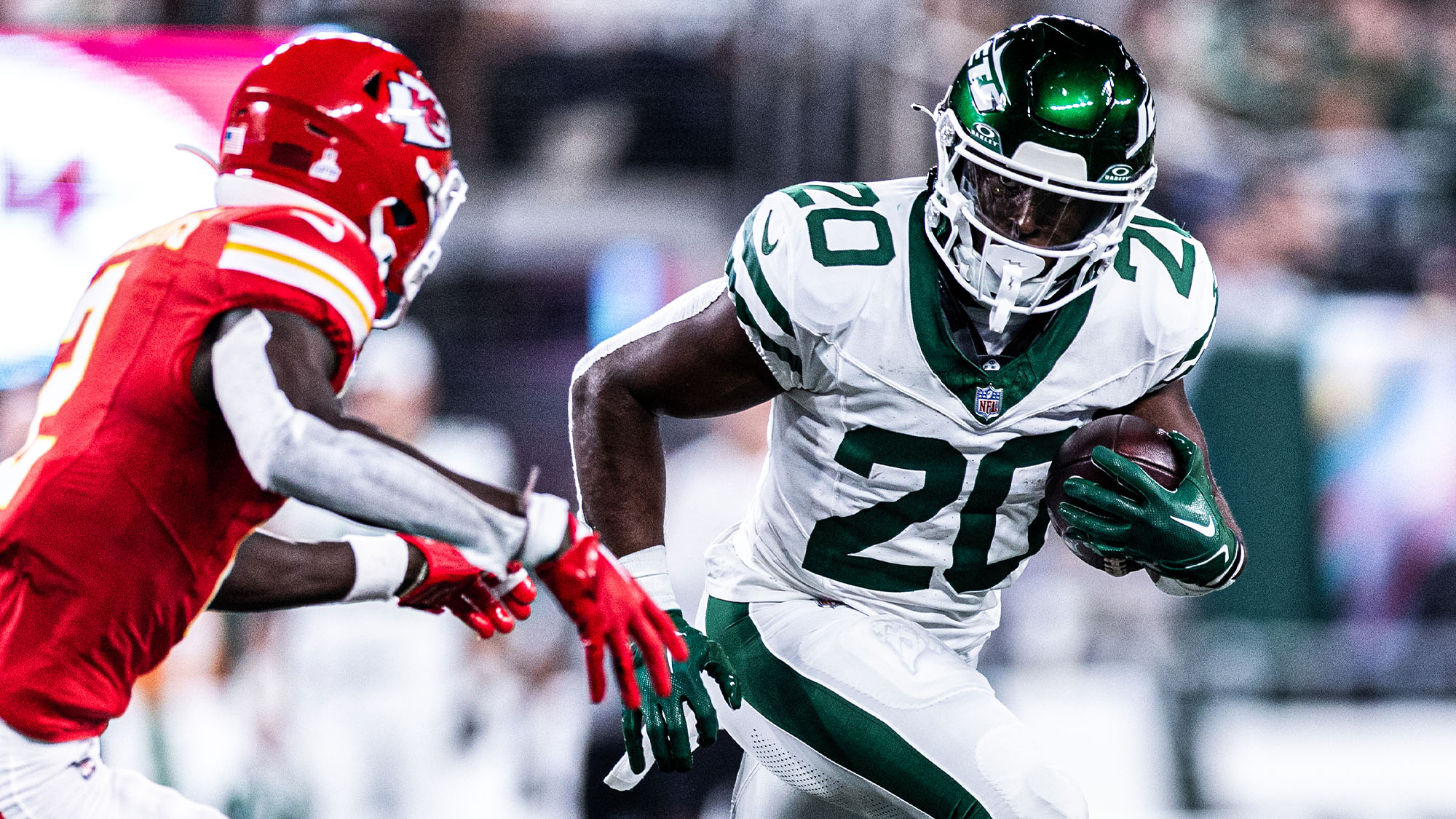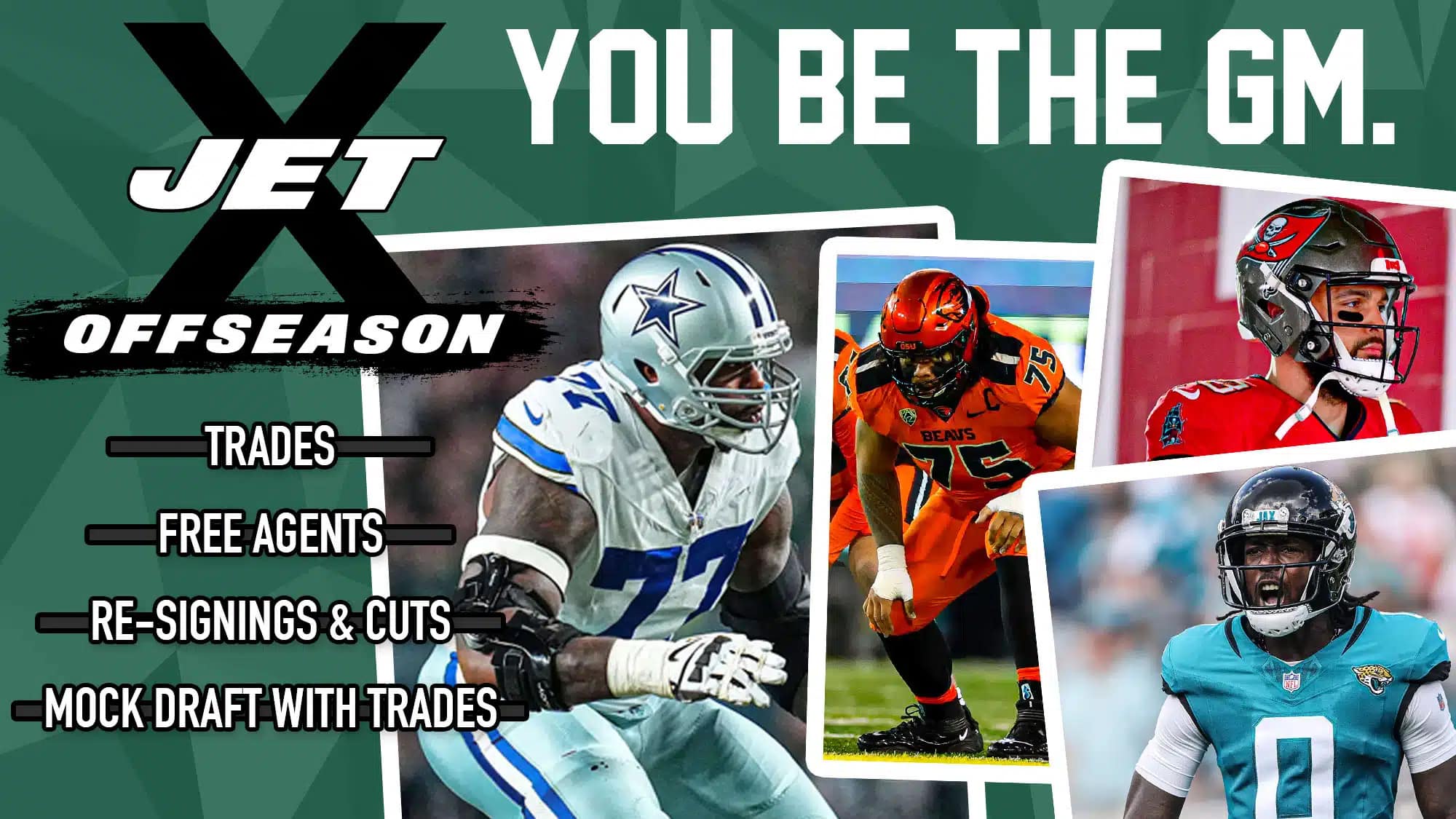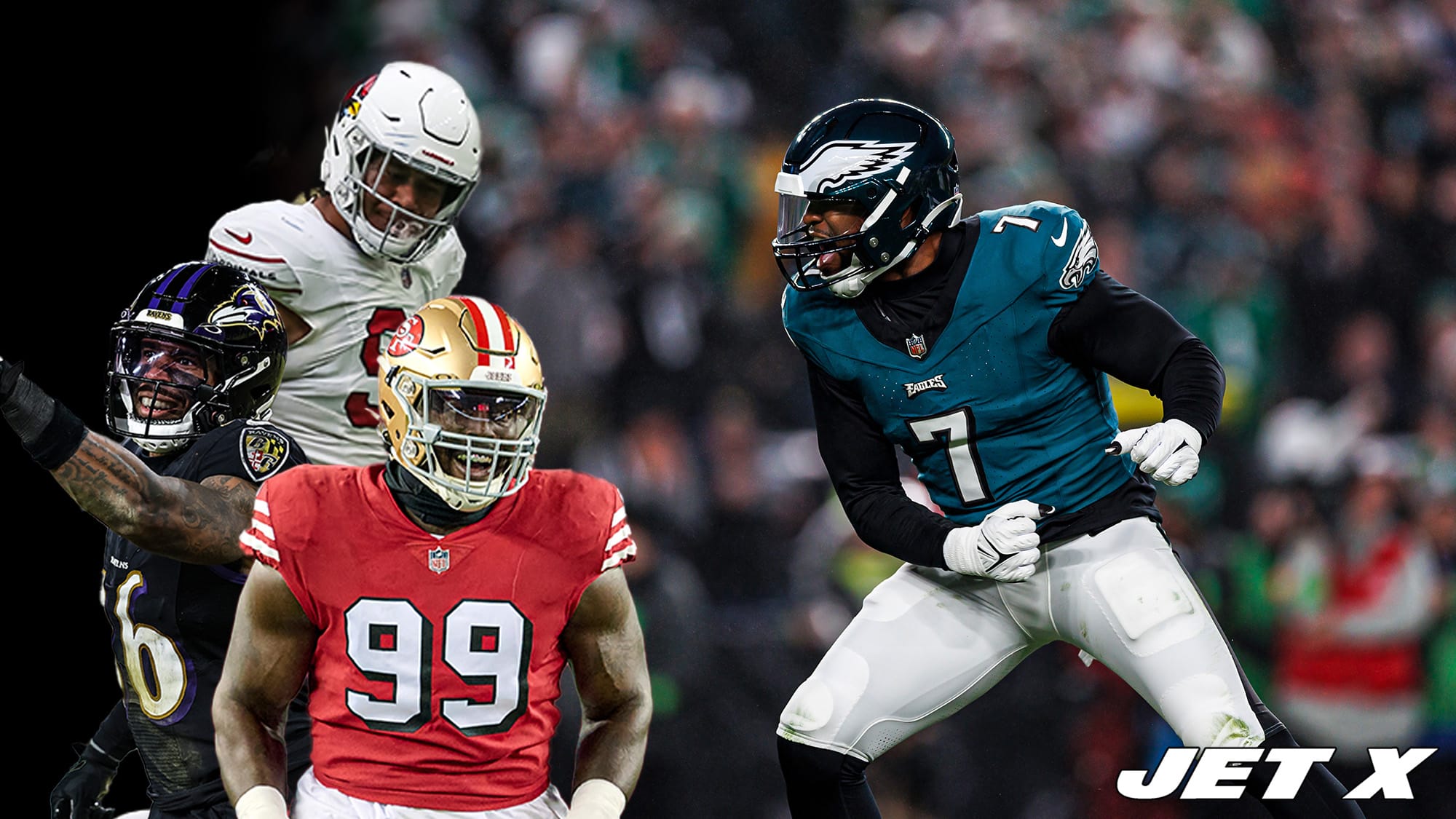It’s about more than just the passing game for the New York Jets
Most of the talk in the world of New York Jets football is centered around Aaron Rodgers. Will he be healthy and able to play at a high level? Can the Jets provide him with good pass protection? Can they get him enough weapons?
All of those questions mainly center around just one phase of the offense, which is the passing game. While the NFL is a passing league and the Jets’ passing game will undoubtedly be the most crucial variable in determining their success, I think a lot of people are glossing over the other phase of the Jets’ offense: the run game.
Play: 👉 the Jet X Offseason Simulator
As much as this is Rodgers’ team, the Jets are built to be a balanced offense. This is not a team that wants its quarterback to drop back over 40 times per game. That was not even the case during Rodgers’ MVP years with Nathaniel Hackett, and it’s definitely not the case now that Rodgers is 40 years old and coming off an Achilles injury.
In Rodgers’ 2021 MVP season, he was only 11th in the NFL in dropbacks (579) and 12th in pass attempts (531). Rodgers averaged 36.2 dropbacks per game and 33.2 pass attempts per game. In terms of their pass-run split, Green Bay landed smack in the middle of the pack, placing 17th with a 58.6% pass play rate.
Simply put, a perfect Aaron Rodgers-led offense involves a healthy balance of the run and the pass.
The Jets need to run the ball well in 2024 to maximize Rodgers’ chances of success. But they have a litany of questions to answer as they seek to do that. Despite having one of the league’s best running backs in Breece Hall, the Jets had the league’s second-worst rushing attack of the 2023 season based on DVOA. Only the Chargers ran the ball less efficiently than the Jets did.
Bottom-5 teams in rush offense DVOA, 2023 regular season:
- 28. Buccaneers (-17.8%)
- 29. Giants (-18.6%)
- 30. Texans (-19.1%)
- 31. Jets (-19.2%)
- 32. Chargers (-20.3%)
Here are some thoughts on the state of the Jets’ run game and how the Jets should address it this offseason.
The Jets are a healthy AVT away from an elite run game
Before we go any further, we need to start with one simple fact: The Jets might be a healthy Alijah Vera-Tucker away from having an elite rushing attack. That alone could be all it takes for this team’s ground game to take off.
On 120 career carries with Vera-Tucker on the field, Breece Hall has gained 730 yards, a whopping 6.08 yards per carry. That would have been the NFL’s best mark in 2023 among the 41 running backs with at least 120 carries. Not only that, but the gap between Hall and the actual leader, Christian McCaffrey (5.36), would be about equal to the gap between McCaffrey and the eighth-ranked David Montgomery (4.63).
Comparatively, Hall has gained just 727 yards on 183 career carries with Vera-Tucker off the field, just 3.97 yards per carry. That would have ranked 26th out of 41 qualifiers.
On-off splits could be skewed by a handful of home-run plays, and Hall does have a few of those with Vera-Tucker on the field. However, there is evidence that suggests Vera-Tucker’s presence truly does have a significant impact on the quality of New York’s overall run blocking.
NFL Next Gen Stats estimates “expected” yards per carry (xYPC) by using player tracking data to evaluate the space the running back is given. With Vera-Tucker off the field in his career, Hall has averaged 3.8 xYPC, a mark that would have ranked 34th among 41 qualifiers in 2023. With Vera-Tucker on the field, Hall’s xYPC climbs to 4.23, which would have ranked 11th out of 41 qualifiers. That’s a 23-spot leap.
Whether he is at guard or tackle, Vera-Tucker uses his unique athleticism to create opportunities for Hall to get out in space and maximize his breakaway speed. This allows Hall to be more dynamic as a playmaker.
Hall averages 1.9 RYOE (rushing yards over expected) per carry with Vera-Tucker on the field, a mark that would have led qualified running backs in 2023. He’s able to do that because of Vera-Tucker’s consistency at opening up second-level chances for him. It’s those second-level plays where Hall can zoom past defenders and rack up large chunks of RYOE.
Couple Hall’s elite 1.9 RYOE with his solid 4.2 xYPC when Vera-Tucker is on the field, and you get his otherworldly 6.1 YPC.
Check out the wheels from Alijah Vera-Tucker…
According to NFL Next Gen Stats, AVT hit a max speed of 18.1 mph on this play.
It remains the fastest speed reached by an offensive lineman in the NFL this season. pic.twitter.com/6z7qaiiTzt
— Michael Nania (@Michael_Nania) January 8, 2023
Breece Hall running wild behind Alijah Vera-Tucker#Jets pic.twitter.com/KalrGBPkSo
— Michael Nania (@Michael_Nania) January 29, 2023
Considering Hall was similarly dominant behind Vera-Tucker in both 2022 and 2023, it seems fair to believe his success with Vera-Tucker on the field is something that can be maintained over a full season. It might be a bit ambitious to suggest he can run for more than six yards per carry over a full 17-game slate, but he is undoubtedly capable of matching McCaffrey’s league-leading 5.36 YPC in 2023.
The Jets’ offensive line has been a total mess outside of Vera-Tucker over the past two seasons. It shows when he’s off the field. Yet, his presence alone is enough to make Hall look like the best running back in football. We’re going to discuss more ways the Jets can improve their run game, but make no mistake – a healthy AVT might be all they need.
Should be able to get more attempts as a result of better passing
One major problem with the Jets’ 2023 run game was a lack of opportunities. The Jets had the league’s fourth-highest pass play rate at 63.2%. Because of this, they averaged the fourth-fewest rush attempts per game at 22.8. New York needs to run the ball more often than that in 2024 to lighten the load for Rodgers.
Obviously, this is not something the Jets intended. It occurred as a result of the offense constantly putting itself in a hole on the scoreboard, forcing the Jets to enter pass-heavy mode for much of the game. This was particularly evident in the second half of games, as the Jets averaged an NFL-low 10.4 second-half rush attempts per game.
A healthy Rodgers would allow for the Jets to strike a better balance. Ironically, the main reason for the Jets’ high rate of pass plays was the passing game’s own ineptitude. The Jets certainly didn’t get into holes because of their defense, which carried the team on its back all year. The run game contributed to digging the holes, but ultimately, it was a putrid passing game that forced the Jets into catch-up mode on a weekly basis, thus forcing even more pass attempts from said putrid passing game. It was a cycle of utter despair.
As much as the run game can help Rodgers, Rodgers will help the run game. The Jets will be able to run the ball throughout all 60 minutes when they aren’t down 17-3 at the start of every fourth quarter.
Lightening the box should also help
Another way Rodgers can help the run game is by forcing defenses to lighten the box.
Since opponents had absolutely zero fear of Zach Wilson beating them over the top, they were comfortable with placing extra defenders near the line of scrimmage to stop the run game. It was a worthy trade-off because the Jets rarely maximized the advantageous matchups yielded by loaded boxes. If they won’t punish us through the air, why not just overpopulate the box and ensure Breece Hall can’t beat us?
Take a look at this play, for example. This is the Jets’ very first offensive play against the Cowboys. Right out of the gate, Dallas shows no fear. There are eight Cowboys defenders in the box compared to only seven Jets blockers. Result: Loss of four yards.
Yes, C.J. Uzomah blocks abysmally here, but the play is doomed from the start regardless. New York is outnumbered, and when that happens, you are not going to run the ball well no matter who you have at running back or who is blocking for him.
Rodgers’ presence will lead to far fewer plays like this one. Defenses could get away with that look against Wilson, but Rodgers will check out of that run play and make you pay for leaving Garrett Wilson in a one-on-one matchup.
Offseason additions?
Offensive line
I’ve mentioned this consistently when discussing the Jets’ offensive line plans, but I do think the Jets should prioritize pass protection when looking for new linemen this offseason. Protecting Rodgers comes first. If they have to add some linemen who thrive in pass protection but struggle in the run game, so be it.
The things we have discussed so far are the reasons New York can be comfortable with this mentality. Vera-Tucker has shown he is enough of a difference-maker to lift the entire run game regardless of who is around him. On top of that, Rodgers’ presence will add multiple benefits that should naturally improve the run game.
As long as the Jets have Aaron Rodgers, Alijah Vera-Tucker, and Breece Hall on the field, their run game should be just fine. With that being said, they should still keep the run game in mind when evaluating potential new players this offseason. After all, Rodgers and Vera-Tucker combined to play six games last season, so they’re not exactly reliable.
For offensive linemen, the Jets should place a premium on scheme fit. Again, I think pass-blocking comes first, so the Jets shouldn’t go after beastly run blockers if it will cost them in pass protection. What they should do is look for players who have good pass blocking reputations and shaky run blocking reputations, yet their run blocking ability can be maximized in the Jets’ scheme. Maybe there’s a player out there whose market value is at a low point because he was miscast in someone else’s run scheme, but he could be made to look better in the Jets’ run scheme.
Ravens guard Kevin Zeitler is someone who might fit that bill. Zeitler is known as a fantastic pass blocker, but he’s 34 years old and produced average numbers in the run game last year. His age and mid-level run blocking could lower his value to a number that is affordable for the Jets, yet Zeitler’s run blocking could be much better in New York. Zeitler played in a gap-heavy scheme with Baltimore, but there is evidence that he would perform better in a zone scheme.
Zeitler is probably the most high-profile example of what I’m talking about, but there are numerous potential fits at various tiers of the free agent market. Simply put, the Jets need to find players who might outperform their market valuation thanks to their fit within the Jets’ offense.
To do it, the coaches and the front office must be on the same page. The coaches must communicate to the front office which particular skills might be more valuable in the Jets’ offense than other schemes, and the front office must use that info to their advantage.
Tight end
Improving the run game does not have to be limited to the offensive line. The Jets also have multiple issues related to the run game at non-offensive line positions. First and foremost, tight end.
The Dallas clip from earlier is just one of numerous reps where C.J. Uzomah was the primary reason that a run play failed. Uzomah’s blocking was bad enough to eventually land him a seat on the bench. He is a likely cut candidate in the coming weeks.
Uzomah was replaced by Jeremy Ruckert. While Ruckert’s flashes as a blocker are encouraging, his blocking was inconsistent once he began to receive consistent snaps. Rivka Boord displayed Ruckert’s erratic blocking in this film breakdown.
New York should seek out quality blocking tight ends who can challenge Ruckert for the TE2 spot behind Tyler Conklin. With Uzomah likely gone, they won’t have a third tight end set in stone, so they need to add another tight end to complete the roster. This should be a player who thrives as a blocker. Receiving skills can take a back seat here. The Jets need to get better blocking out of the tight end position than they did last year and they cannot fully rely on Ruckert to provide it.
Running back
The Jets also need to strengthen the running back depth chart behind Hall. Israel Abanikanda is the only other player on the roster with significant NFL playing time, and he struggled as a rookie. More competition and depth are needed.
The running back production behind Hall is one of the largest potential areas of improvement for the Jets’ run game. While the Jets’ 2023 run game woes were primarily due to the poor blocking and the QB limitations, Dalvin Cook’s stagnant running was another reason the Jets were so inefficient at running the ball.
Cook received 67 carries and could not score a touchdown or record a run of longer than 14 yards. Among running backs with at least 60 carries, he ranked last in RYOE per carry (-1.2) and second-worst in yards after contact per carry (2.2).
Even on a small volume of carries, Cook left a ton of yards on the table due to his severe lack of playmaking ability. And that’s with the Jets being lucky enough that Hall never got injured. If Hall ever went out and the Jets were forced to deal with a full game of Cook as their top back, it would have been excruciatingly hard on the eyes.
The Jets need better security from the RB2 spot than what Cook provided. They probably do not have the resources to address the position with even a mid-level investment in free agency or the draft, so they will have to try and find steals in the bargain bin of free agency or the later rounds of the draft. It’s arguably the easiest position to locate steals – think of how many unheralded RBs emerge out of nowhere each year – so it’s a challenge the Jets’ scouting staff should be up to if they’re worth their salt.













Commentators always talk about AVT as though his odds of getting injured next year have gone down because he was injured the year before. They did this last year, and now they’re doing it again. The risk hasn’t changed, and if anything it has gone up because of his history. Plus, he might be impaired this year as he recovers from his Achilles tear. Any Jets plans for the OL that lean heavily on AVT being at his best or even available through the season are extremely unwise. If I were JD, I would plan for the OL as though AVT was a very uncertain component.
I love this breakdown because I have always believed the best pass protection is a strong run game. When defenses are off balance they can’t tee off on the QB. They have been teeing off for a while now. It also opens up the playbook and keeps the offense out of 2nd/3rd and long. All of that will help. That’s not to say they don’t need to be good pass blockers but establishing a consistent run game will go a long way.
AVT is a key player, but I do have concerns he can come back as if he never missed a beat. This is an Achilles tear which could be more difficult on a big guy, not to mention he’s now been basically out of football for 2 seasons. I do worry about how long it will take him to return to form.
The addition to the backfield should be AJ Dillon. He’s played with them before and he’s the big bruising guy that helps wear down a DL. He’s been productive and would be a nice mix with Hall and Izzy. I don’t trust Hackett with RB rotations but I think Dillon would be a huge help.
I wouldn’t be surprised if they find a “blocking TE” to add to the team, or… a FB in the draft. I’m not a fan of these “TE’s who can play FB” I’m talking about a real FB. Ben Sinnott type player. Fans won’t be happy but I I also wouldn’t be surprised if they run it back with the TE group. Honestly, I’m ok with that move. I’d like to see what that group could do with Rogers.